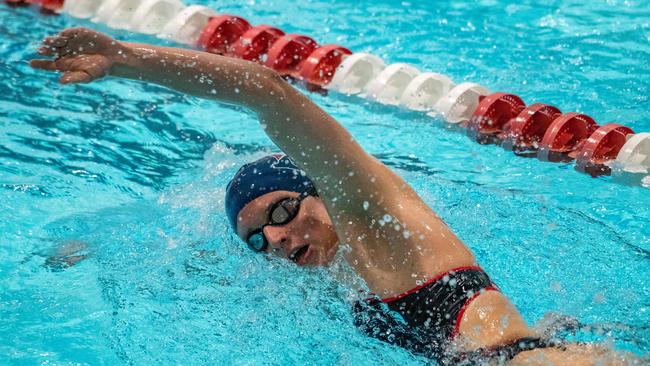The case for and against banning transgender athletes from elite sport
Columnists Rita Panahi and Susie O’Brien argue the case for and against banning transgender athletes from elite sport following FINA’s historic vote.

Opinion
Don't miss out on the headlines from Opinion. Followed categories will be added to My News.
THE CASE FOR - RITA PANAHI
In the end sanity prevailed. Reality trumped fantasy. Facts beat feelings. And fairness triumphed over a twisted version of ‘inclusion’ pushed by radical trans activists.
FINA, world swimming’s governing body, made the only rational decision possible and restored fairness to the women’s competition by imposing bans on transgender athletes.
But don’t expect facts or logic to sway the biology deniers among the activist class and their enablers in the media.
Indeed it is increasingly difficult to separate the two groups given how readily many in the media regurgitate the incoherent talking points pushed by trans activists.
The notion that excluding athletes born male but identifying as female is somehow “exclusionary” is laughable. Those athletes are free to compete but in the male category.
Of course it is much easier to excel in the women’s category but that is hardly fair to the natural born girls and women who do not have the same anatomical and biological advantages as athletes born male such as muscle mass, lung capacity, and heart size.

As Abigail Shrier, author of the groundbreaking book, Irreversible Damage: The Transgender Craze Seducing Our Daughters, wrote in a 2020 piece, the gap between male and female athletes is astonishing: “Consider Allyson Felix, a contender for the title of fastest female sprinter in the world, who holds more Olympic medals than even Usain Bolt. Her lifetime best for the 400m is 49.26 secs. Based on 2018 data, nearly 300 high school boys in the US alone could beat it.”
And, that advantage is felt right through the sporting ranks. Why should girls and young women miss out on opportunities including sporting scholarships to accommodate trans women?
There is nothing inclusive or fair about an ideology that is essentially a new age form of misogyny that puts the interests of a small group of male-bodied athletes identifying as female above what’s best for half the human population.
More than 70 per cent of FINA members voted for the organisation’s new “gender inclusion policy” after hearing from representatives from three specialist groups, athletes, science and medicine and legal and human rights.
Most sensible folk across the political spectrum can see through the malarkey pushed by far Left activists but sadly academia, the media and both public and private institutions are largely in the thrall of the trans agenda.
The public, on the other hand, can still discern what is fair and right. This paper’s online poll showed only 2 per cent of respondents were against FINA’s ruling.
The reality is that men and women are different and pretending otherwise only hurts female competitors. Male bodies cannot become female no matter what concoction of drugs are consumed, this is something that many high-profile trans women acknowledge, including Caitlyn Jenner and Blaire White.
Men are bigger, faster and stronger. The very best female athletes in the world have no chance of beating male competitors, whether it’s in basketball, tennis, athletics or swimming. Women’s sport must be protected from school competitions all the way through the elite ranks.
THE CASE AGAINST - SUSIE O’BRIEN
Swimming’s global governing body has just released a gender exclusion policy, not a gender inclusion policy.
The landmark new approach allows transgender men to take part in the male competition but excludes all transgender women from competing in elite swimming regardless of their size, strength or physical capacity.
It states that only transgender women who have transitioned before the age of 12, and who have not been through male puberty, can enter the women’s competition.
There are few – if any – countries where gender transition is legal before the age of 16, meaning this is a complete ban.
While it’s essential that there are safeguards to protect females from competing against stronger, larger males, this seems like a dangerous over-reaction.
I agree that male and female competitions should remain separate, but there is room for assessment on a case-by-case basis given that there are only a handful of elite transgender athletes.

FINA relies on “science” to argue that the male sex confers an automatic and unalienable advantage that cannot be overcome by medical intervention or personal characteristics.
This overlooks the fact that there is scientific evidence to back up an approach that assesses each transgender athlete on their own merits and abilities, and which shows that male advantage can be either non-existent or nullified over time.
Yes, some transgender women may have bigger bones, lungs, feet and hands than other women, but this is not true of all.
A more individual approach would protect women competitors but also allow some transgender athletes if they meet stringent criteria in terms of size and ability.
The danger is that the one-size-fits-all approach will filter down to the community level where people are playing for fun and friendship, not Olympic medals.
As the mother of a daughter who plays club and school sport, I am well aware of the need to protect girls against the possibility of competing against transgender females who may be much stronger and more powerful.
But at the same time, this must be balanced against the rights of transgender children to take their rightful place in sporting teams at every level.
Not only is this inclusion their legal right, but it’s something we all have a moral obligation to ensure. Transgender children are among the most vulnerable members of our community, and they deserve to have the same opportunities as any other kids.
FINA has established an “open” category but that is a meagre peace offering to the transgender community that could end up completely meaningless because of the low numbers of trans athletes at this top level.
FINA has set the stage for the demonisation and exclusion of transgender women athletes for many years to come.
This is not inclusion, it’s discrimination and exclusion.



